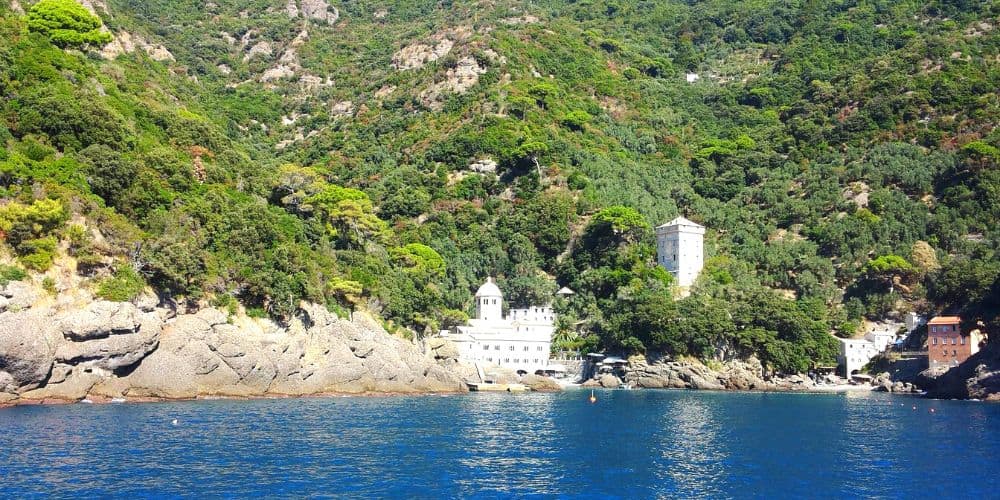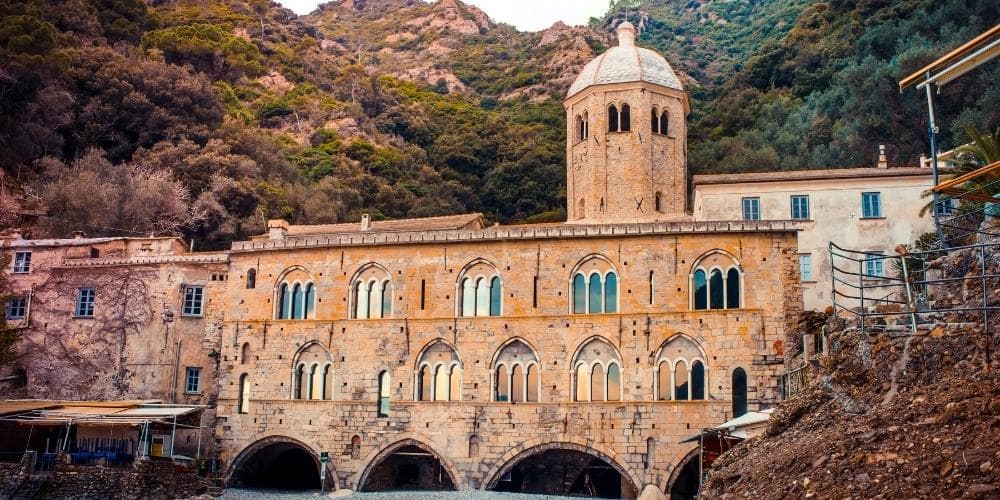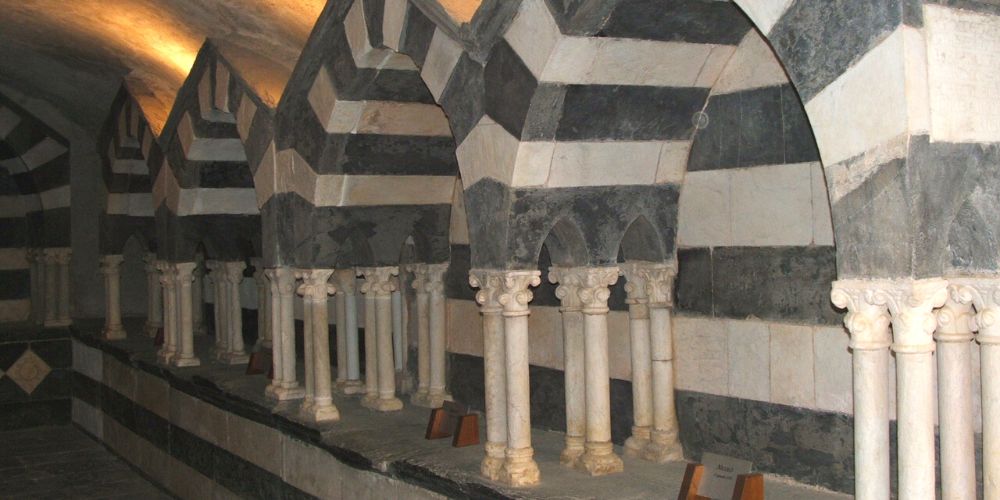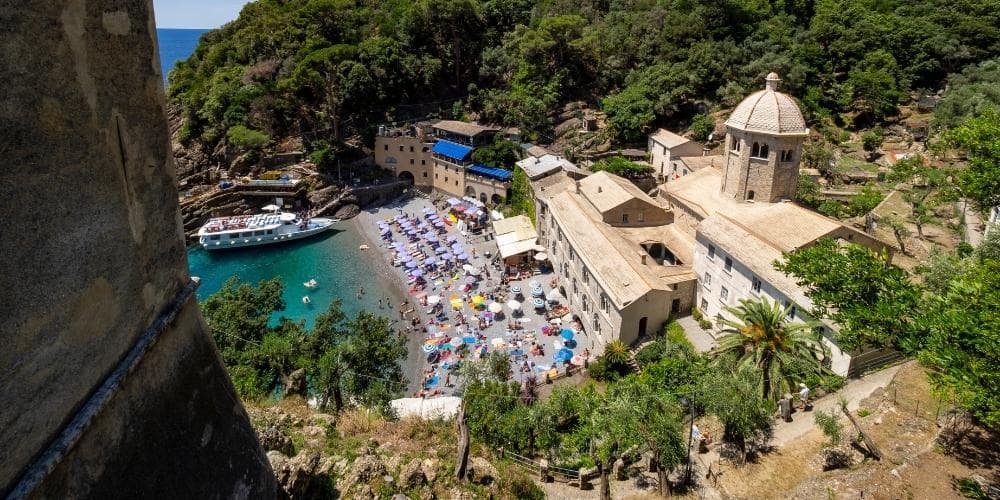A place where time stands still so much that it can only be reached only on foot with a walk of about an hour, or by sea: this is the splendid Bay of San Fruttuoso di Capodimonte, in eastern Liguria.
The nature of the bay is undoubtedly the protagonist, but also the perfect setting for the small fishing village of San Fruttuoso. Here, for importance and beauty, the enchanting Benedictine Abbey dominates, a FAI heritage site since 1983.
Then, whether on foot or by boat, without any further hesitation let's unveil the treasures of this corner of Liguria.

The fishing village: a magnificent place inside Portofino Natural Park

Nestled between 33 hectares of Mediterranean scrub and the beautiful sea of eastern Liguria, there is the small village of San Fruttuoso. Boats depart daily from its marina for Camogli and Portofino, as well as for Tigullio, the Bay of Silence and Genoa.
In this village, a handful of fishermen's houses, a beach and a small church, one of its two great symbols watches over: the Doria Tower. Commissioned in the mid-sixteenth century by the famous admiral Andrea Doria, the tower was meant to defend the promontory from frequent attacks from the sea.
And if you decide to stretch your gaze towards those blue waters, right there, about 30 meters from the shore, you should know that one of the most famous dive sites in the region is located there: the Christ of the Abyss.
The Christ of the Abyss, lying on the seabed
Submerged about 17 meters deep, the famous statue of the Christ of the Abyss is about 2.5 meters tall and weighs about 260 kilograms. Its huge bulk was laid on purpose on the seabed in the mid-twentieth century.
It was an idea of Duilio Marcante, an Italian diver and one of the founding fathers of this activity. It was actually he who came to theorize the educational method of approaching diving. With the statue, later made by sculptor Guido Galletti, they wanted to commemorate Dario Gonzatti's death at sea. Not only that, the arms of Christ aiming at the sky are meant to be an unequivocal symbol of peace.
The beautiful bronze sculpture can be admired by diving or, if visibility is good, even from the surface of the water, using a bathyscope. Moreover, as early as 1974, a copy of the statue has been kept just inside the Church of San Fruttuoso. The plaster original, on the other hand, is located in Marina di Ravenna.
Every year, on the last Saturday of July, the Feast of the Christ of the Abyss is celebrated, an evocative ceremony to remember all those who have disappeared at sea. The festival takes place after sunset, when the entire village of San Fruttuoso is illuminated only by the light of torches and candles. A procession accompanies the blessing of the waters followed by a dive by divers who lay a laurel wreath on the statue.
And now, we are finally ready for a look at the beautiful Abbey that faces the sea.
The Abbey of San Fruttuoso, a precious piece of history between land and sea

Legend has it that it was the Bishop of Tarragona, Fruttuoso, who chose this place for his remains. In fact, the Bishop, a third-century martyr, appeared in a dream to five monks, where he indicated that, along the Ligurian coast, they would find the ideal place for his burial. It would be identifiable by three signs: a fierce dragon, a cave, and a spring of water.
Guided by an angel, therefore, the monks arrived at Capodimonte. Having annihilated the dragon and found the other symbols, legend has it that they then built the chapel. The remains of San Fruttuoso actually rest today in a silver casket on the high altar of the church.
In any case, however, an early construction of the Abbey of San Fruttuoso dates back to the 9th century, then rebuilt between the 10th and 11th centuries. Just then it was entrusted to Benedictine monks who added a floor to the building.
After many centuries of presence of the Doria's, years of abandonment and use of the abbey as a private residence followed. Finally, in 1983, the Doria Pamphilj family donated the Abbey to FAI (the National Trust for Italy).
To retrace the events at their best, it is possible to visit the interior of the monastic complex, in whose rooms there is a museum dedicated to the history of the abbey. Embellished with Romanesque-style architecture, several tableware ceramics discovered in a monastery storehouse are on display, and all of them are of the most varied origins.
The Cloister of the Abbey: on the footsteps of the Doria family

The glorious years, however, were mainly due to the Genoese Doria family, who enlarged and enriched it during the long period in which they owned it. It was in fact that family who promoted the construction of the great Doria tower and the loggia with two orders of three-mullioned windows from the thirteenth century. Still visible today on the two facades looking at the sea there is the coat of arms of the Doria family, depicting the imperial eagle.
Thanks to the family, the upper cloister was also rebuilt in the sixteenth century. The interiors are magnificent, with an important use of Romanesque-style capitals as well as columns of different styles.
On the lower level, however, is the tomb of the Doria family, granted to the latter by the Benedictine monks themselves. Here are the 12th- and 13th-century tombs of as many as seven members of the family. They are bicolored, as is typical of the Ligurian style, in white marble and gray stone.
Next to them are two other tombs and a Roman sarcophagus, but the identity of these illustrious people is still unknown.
How to arrive in San Fruttuoso: by train, boat or on foot?

Undoubtedly, the easiest way to get to the Bay of San Fruttuoso is from the sea, traveling along one of the most beautiful stretches of the Ligurian coast.
In fact, public service boats depart year-round from Camogli. In the summer months, there are additional routes from Genoa, Portofino, Santa Margherita, Rapallo, Chiavari, Recco, and Sestri Levante.
Alternatively, it is possible to reach the fishing village by train. In fact, the Camogli-San Fruttuoso railway station is only a few hundred meters from the pier.
The most adventurous way, however, is undoubtedly to reach the village by walking along the paths of the Portofino Natural Park, which vary in length and intensity. However, the arrival at San Fruttuoso is almost all downhill, the return will be mostly uphill.
In any case, it will certainly be a hike you will not forget!
About the author
Written on 22/06/2022


Claudia Prezioso
San Fruttuoso Bay is a picturesque inlet along the coast between Camogli and Portofino. Between woods and sea, the iconic Abbey stands out.